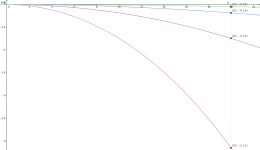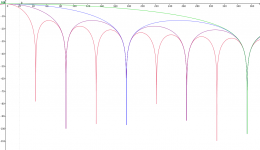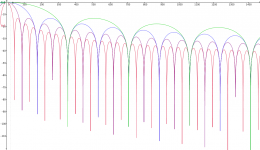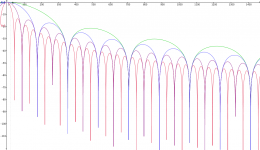Listened to NQtb65, NQtb70 and NewNOS today. All three are pretty nice. But NewNOS feels distinctively more dynamic, direct and more full-bodied. This is the first time I heard a NOS filter, but I am very surprised at how good it sounded despite the nasty graphs of the aliases (to my ears anyway).
Thank you Paul for creating all these filters, such great education.
Thank you Paul for creating all these filters, such great education.
Listened to NQtb65, NQtb70 and NewNOS today. All three are pretty nice. But NewNOS feels distinctively more dynamic, direct and more full-bodied. This is the first time I heard a NOS filter, but I am very surprised at how good it sounded despite the nasty graphs of the aliases (to my ears anyway).
Thank you Paul for creating all these filters, such great education.
The NOS filters are interesting. They should sound really bad but actually perform very well in a lot of the areas people claim determine good sound.
And thanks for making those observations. It got me thinking...
cheers
Paul
A diversion by way of NOS
After reading ylingf's comments I plotted up the NOS filter and as you'd expect it's all "trunk" and no "ears". In other words there is no time smear.
That got me thinking. If we can filter in such as way as to push the "time smear" out of the audio band as far as possible, we might be able to many of the benefits of NOS without the mirror images out to infinity (or there abouts).
This one should make oneoclock very happy 😉
It is short - only 128 co-efficents long and has very little ringing.
The flip side is it's very slow roll-off and is -2dB at 19kHz and only fully attenuates at 33.5kHz.
It's a bit of a return to the earlier slow roll off filters, but the difference this time around is I [think I] understand what I'm trying to achieve rather than trying to copy commercial impulses 😉
I'm not sure if this will clip. It's possible it will due to the mirror image above 22.05khz.
This performs better with the LEDR™ test than the recent NQ versions. There is more clearly defined progression of Up and Over for instance.
see: Take Me to Your LEDR! | Stereophile.com
You'll have to excuse the TotallyCRaP naming, but I need to keep track of what configuration is used and it's easier to use something meaningful.
BTW this is still the Nyquist, keeps original samples stream. Main change is I'm trying out the Chebyshev window to control the level of side lobe attenuation, instead of sticking with kaiser windowing.
Listening to this, I believe it is a big improvement on the earlier NQ filters. The balance is very natural on my system. The other big gain is that drums and bass are better defined and with more accurate attack, rather than the rounded character that was evident. Listening to David Sylvian's Gone to Earth - which I've used as a reference for longer than I care to remember - the recording has regained the punch in the drums and bass it should have.
After reading ylingf's comments I plotted up the NOS filter and as you'd expect it's all "trunk" and no "ears". In other words there is no time smear.
That got me thinking. If we can filter in such as way as to push the "time smear" out of the audio band as far as possible, we might be able to many of the benefits of NOS without the mirror images out to infinity (or there abouts).
This one should make oneoclock very happy 😉
It is short - only 128 co-efficents long and has very little ringing.
The flip side is it's very slow roll-off and is -2dB at 19kHz and only fully attenuates at 33.5kHz.
It's a bit of a return to the earlier slow roll off filters, but the difference this time around is I [think I] understand what I'm trying to achieve rather than trying to copy commercial impulses 😉
I'm not sure if this will clip. It's possible it will due to the mirror image above 22.05khz.
This performs better with the LEDR™ test than the recent NQ versions. There is more clearly defined progression of Up and Over for instance.
see: Take Me to Your LEDR! | Stereophile.com
You'll have to excuse the TotallyCRaP naming, but I need to keep track of what configuration is used and it's easier to use something meaningful.
BTW this is still the Nyquist, keeps original samples stream. Main change is I'm trying out the Chebyshev window to control the level of side lobe attenuation, instead of sticking with kaiser windowing.
Listening to this, I believe it is a big improvement on the earlier NQ filters. The balance is very natural on my system. The other big gain is that drums and bass are better defined and with more accurate attack, rather than the rounded character that was evident. Listening to David Sylvian's Gone to Earth - which I've used as a reference for longer than I care to remember - the recording has regained the punch in the drums and bass it should have.
Attachments
Last edited:
Thanks for your great effort 🙂 Looking forward finishing work today and test your new filter 🙂
Thumbs up!
If we can filter in such as way as to push the "time smear" out of the audio band as far as possible, we might be able to many of the benefits of NOS without the mirror images out to infinity (or there abouts).
Thumbs up!
Looking pulse signal on the scope, pflaumer's filter in alpha dac lasts significantly longer than eg. sabre dac filter or dam filters. Alpha dac has 4 filters but berkeley audio suggests using filter 1 for listening; the other 3 are there to enable tone engineer to hear how the mastering will sound on usual dac/cd player. Those other filters also have shorter duration than filter 1.
The other big gain is that drums and bass are better defined and with more accurate attack, rather than the rounded character that was evident. Listening to David Sylvian's Gone to Earth - which I've used as a reference for longer than I care to remember - the recording has regained the punch in the drums and bass it should have.
The bass of the dam has always been way behind my IansFIFO/iso/clock/pcm-i2s/AYA14, hopefully this will do the trick!
For the friends of NOS:
The Impulse response of NOS is 64 samples full scale at the final sample rate (of 64*44.1kHz). Its frequency response is thus the sinc function, more precisely the same you would see with a 44.1kHz DAC unfiltered, with the 3dB attenuation at 20kHz.
If you want to solve this the NOS-way, by choosing less samples full scale as impulse response (corresponding to the sinc with respect to higher sample rates). The attached graphs show the frequency response for
NOS=64 samples (red), 32 samples (purple), 16 samples (blue), 8 samples (green).
The x-axis is the frequency in kHz, the y-axis dBFS.
The first three are the "modified" NOS filter frequency response for different frequency ranges.



Finaly the (theoretical) frequency response at the output of the DAC, thus including the analog low pass. Thus lot of HF is comming through.

I also attached the corresponding filters (32=NOShalf, 16=NOSquart, 8=NOSoct). I listend to them, each gets 6dB quitter, and sound as expected like NOS, I do not really hear the flattening in the audio band... but I fear my ears got somehow saturated this weekend, currently all filters sound more or less equal to me.
The Impulse response of NOS is 64 samples full scale at the final sample rate (of 64*44.1kHz). Its frequency response is thus the sinc function, more precisely the same you would see with a 44.1kHz DAC unfiltered, with the 3dB attenuation at 20kHz.
If you want to solve this the NOS-way, by choosing less samples full scale as impulse response (corresponding to the sinc with respect to higher sample rates). The attached graphs show the frequency response for
NOS=64 samples (red), 32 samples (purple), 16 samples (blue), 8 samples (green).
The x-axis is the frequency in kHz, the y-axis dBFS.
The first three are the "modified" NOS filter frequency response for different frequency ranges.



Finaly the (theoretical) frequency response at the output of the DAC, thus including the analog low pass. Thus lot of HF is comming through.

I also attached the corresponding filters (32=NOShalf, 16=NOSquart, 8=NOSoct). I listend to them, each gets 6dB quitter, and sound as expected like NOS, I do not really hear the flattening in the audio band... but I fear my ears got somehow saturated this weekend, currently all filters sound more or less equal to me.
Attachments
Last edited:
The bass of the dam has always been way behind my IansFIFO/iso/clock/pcm-i2s/AYA14, hopefully this will do the trick!
More in terms of the other nyquist filters, rather than compared with other DAC's I'm afraid.
Listening to this, I believe it is a big improvement on the earlier NQ filters. The balance is very natural on my system. The other big gain is that drums and bass are better defined and with more accurate attack, rather than the rounded character that was evident. Listening to David Sylvian's Gone to Earth - which I've used as a reference for longer than I care to remember - the recording has regained the punch in the drums and bass it should have.
Hi Paul,
I think this new filter is a huge improvement. Very very close to the openness of the NOS filter. Now i have to listen much more carefully to tell the difference. Need to spend more time on it before I can comment more.
One difficulty I have is the different gains between filters. Without closely matching the gains, I am so afraid to start spilling out BS.
Also, how do you switch between filters without unplug/plug the power supply? I tried switching input from putty, I think it forced the input change, but not sure if it guarantees the filter change too.
As always, thank you so much for your great work!
For the friends of NOS:
I also attached the corresponding filters (32=NOShalf, 16=NOSquart, 8=NOSoct). I listend to them, each gets 6dB quitter, and sound as expected like NOS, I do not really hear the flattening in the audio band... but I fear my ears got somehow saturated this weekend, currently all filters sound more or less equal to me.
Hi Zfe,
Sorry for my ignorance. What are the differences between these filters and NOS?
Thanks,
The original NOS filter maps a sample s to the 64 times repeated sample s (at output sample rate 64*44.1kHz).Hi Zfe,
Sorry for my ignorance. What are the differences between these filters and NOS?
Thanks,
The modified NOS only map it to fewer duplicates and fill the rest with zero. This has the effect that the frequency response (as seen in the graphs) is "stretched". And therefore the audio band is flatter, while still having "the ideal impulse response" (at the price of very little damping the unwanted higher frequencies).
Hi Paul,
I think this new filter is a huge improvement. Very very close to the openness of the NOS filter. Now i have to listen much more carefully to tell the difference. Need to spend more time on it before I can comment more.
One difficulty I have is the different gains between filters. Without closely matching the gains, I am so afraid to start spilling out BS.
Also, how do you switch between filters without unplug/plug the power supply? I tried switching input from putty, I think it forced the input change, but not sure if it guarantees the filter change too.
As always, thank you so much for your great work!
No problem, and glad you are enjoying this one.
I agree it is a big step forward in SQ over the other nyquist filters, and is my current favourite. I find the filters hard to describe, so tend not to try 😉 In this case I find the filter very tonally even. You don't get the sense the filter is "pushing" aspects of the recording to the foreground, as you'd expect from the impulse behaviour. With the LEDR recording there is well defined height and lateral positioning, and this is noticeably improved over the previous versions I checked.
I try to do most of the filters on 6.8333 FIR2 gain, but a few of the nyquist filters were at 8 when I was trying to solve the "perceived HF roll-off" issue.
Søren has said that the filters reload whenever the loses a lock on input.
Just make sure you see feedback on the terminal/putty that indicates the DAM has locked to a sample rate, i.e. L044.
You should get Ix, L044, V-xx whenever the DAM relocks.
Code:
# exit
I1
L044
V-35
I2
I1
L044
V-35Try using I3 if you only have one active input, and remember you need to enter the Ix twice when you first exit from uManager. The DAM will not respond the first time.
Thank you very much for the work Paul.
I have measured and heard 1021 filtNQ_C128x110. It's perfect.
It has everything I want. NOS advantages. Good impulse response. Keeps the original samples. Flat phase. No ringing. Much detail on percussion instruments.
And no NOS disadvantages. Sounds nice, does not disturb, does not tired. Flat amplitude. No problem for digital amplifiers thanks to the higher spectra attenuation.

I have measured and heard 1021 filtNQ_C128x110. It's perfect.
It has everything I want. NOS advantages. Good impulse response. Keeps the original samples. Flat phase. No ringing. Much detail on percussion instruments.
And no NOS disadvantages. Sounds nice, does not disturb, does not tired. Flat amplitude. No problem for digital amplifiers thanks to the higher spectra attenuation.
Attachments
Last edited:
Thank you very much for the work Paul.
I have measured and heard 1021 filtNQ_C128x110. It's perfect.
I'm very happy to read that.
I think this is actually fairly close to what is described as the original Ayre Listen filter, prior to them moving to a minimum phase version. The main concern that was expressed about that filter was that there was distortion from the imaging that increased with frequency.
The only way I can see that issue can be addressed is to make the filter steeper but that would require a longer filter and more ringing. I think it might be possible to tweak so the time smear is shifted higher but that will require some experimentation.
Anyway, for the time being I think this is probably a benchmark filter.
At last have finished building my new Dac built into the same case and alongside my old Tube Tech Dac64 - 5 minutes soldering to switch between the two. The ladder output connects to the valve output stage of the original, I've also outputs on the back from the Dam op-amps.
Been listening to the C128 and NewNOS filters on 24-bit 384kHz input via usb. Edging towards NOS but sometimes does it sound a little distorted? Have to get the scope out. Bu comparison the C128 is well balanced if a little shy when compared with NOS, although certainly no hint of distortion. Have to drop down to 16-bit 44k, and plug in the streamer and CD players and have a listen. Tomorrow...
Thanks to all for the excellent work.
Been listening to the C128 and NewNOS filters on 24-bit 384kHz input via usb. Edging towards NOS but sometimes does it sound a little distorted? Have to get the scope out. Bu comparison the C128 is well balanced if a little shy when compared with NOS, although certainly no hint of distortion. Have to drop down to 16-bit 44k, and plug in the streamer and CD players and have a listen. Tomorrow...
Thanks to all for the excellent work.
Running the C128 - just put on some Diana Krall - very nice! Rater, more like very, very nice!!! Sounds good on both 16/44 & 24/384 albeit a tiny bit more atmosphere and space in the music with the high frequency input.
Been listening to the C128 and NewNOS filters on 24-bit 384kHz input via usb.
I hate to break this to you but at 384kHz you are using bypass filters that won't alter the signal in any way. Both C128 and NOS have a single co-efficent of 1.000 at this position. All you are listening to is the sound of FIR2 which in the case of C128 is flat to 60kHz.
The only difference I can think of is that FIR2 in C128 has a gain of 0.85441625 (6.833 x 8) and the NOS FIR2 has a gain of 1.000 so is about 3dB louder.
So you prefer the one that is a bit louder.
This from C128 config:
Code:
dam1021,352800,1,1,1,1
Input FIR, 352.8 Khz Samplerate, Bypass
1.000
dam1021,384000,1,1,1,1
Input FIR, 384 Khz Samplerate, Bypass
1.000And from NewNOS:
Code:
dam1021,352800,1,1,1,1
Input FIR, 352.8 Khz Samplerate, Bypass
1.000
dam1021,384000,1,1,1,1
Input FIR, 384 Khz Samplerate, Bypass
1.000
Last edited:
I'm still edging toward the NOS filter, female vocals appear to sound more organic. I'm using all tube amplification/preamp so any HF effects don't appear to be an issue. After trying all the filters over the last month you learn a lot about how things should sound, and I also began comparing 44.1k flac's to vinyl releases and its to the point now where the DAM is making me feel like my vinyl collection/turntable was a waste of money. #FirstWorldProblems
Last edited:
- Home
- Source & Line
- Digital Line Level
- Filter brewing for the Soekris R2R

